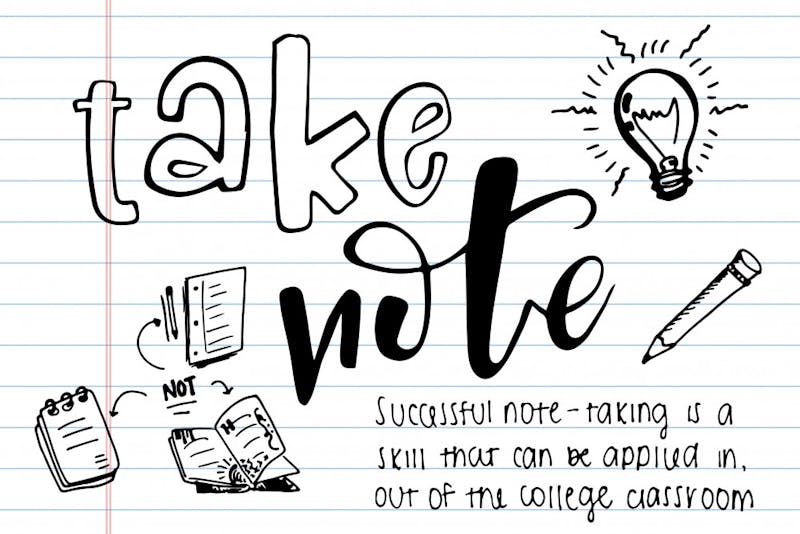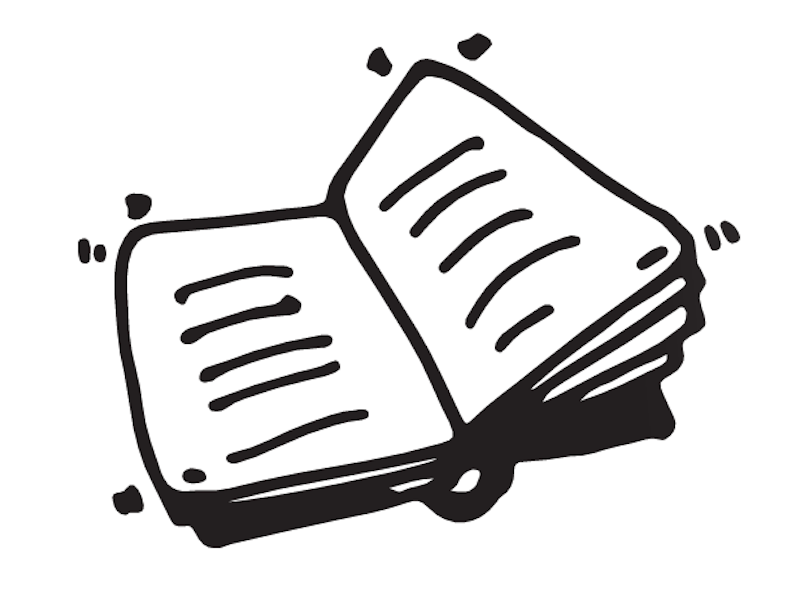
ILLUSTRATIONS BY ALEXA MILLER


ILLUSTRATIONS BY ALEXA MILLER
September 29, 2016
Go to class. Take notes. Take tests. Pass the class, hopefully. It is the academic circle of life.
However, without proper guidance and understanding of how the brain comprehends notes, the cycle can become nearly impossible to complete.

Sue Fletcher, assistant director of academic skills instruction in the Academic Advancement Center at Ohio University, hears it all the time when she is talking to students about studying: “I looked at my notes.”
“That’s the standard for how people say they study,” Fletcher said. “Unless you have a photographic memory, and you take really beautiful notes, staring at your notes is not going to help you learn (the material) nearly as well as if you do something active with them.”
Note-taking is just a tool to advance the studying process, said Jeff Vancouver, a professor and William C. Byham Chair in Industrial/Organizational Psychology. But, it is a tool that when done well and accompanied by specific study habits, such as reviewing the material outside of class, can take the content beyond just a one-semester course.
That means taking notes in class, listening, then following it up with reviewing, reading and interacting with those notes. It is a balance and understanding of what works.
“Cramming works in the short-term,” Vancouver said. “You will actually do better on tests you cram for as opposed to spaced practice. … If you space practiced, you’re much more likely to remember the material (after the exam).”
In order to maintain knowledge, note-taking shouldn’t just be writing down the key points from a class, Fletcher said. It is not about transcribing what a lecturer says, nor will that help.
“I think it’s more of a mindset on how you view notes,” Fletcher said. “I think a lot of students view notes as ‘I’ve just got to capture everything that’s said’ instead of looking at it as a study tool.”
Fletcher said taking good notes can change a student’s attitude.
“I think good notes can make a student feel confident about the class,” Fletcher said. “If they take really good notes, they can feel more confident when they study that they know what they need to do. … You have a little bit more ownership in the course because the learning really is on you; it’s not on the professor.”
Created in the 1950s by Walter Paulk. The structure involves splitting a piece of paper into three sections: a right, left and bottom. The right side is for notes during class, the left for adding questions after class, and the bottom section is used for summarizing the content for better understanding.
Using bullet points or numbered lists, outline notes follow simple hierarchy rules: main topics are dissected into smaller points underneath.
With a more artistic approach, concept mapping involves creating webs and threads between understanding and are notes geared more toward visual learners. It is like the outline method’s more artistically-inclined cousin.
Like concept maps, this technique is more artistic. Streamlined by Mike Rohde, author and creator of Sketchnote Army, it’s a visual way to create notes. Julie Elman, associate professor in OU’s School of Visual Communication, said it’s “not full blown illustrations, but it’s not just random doodling.”

When it comes to starting the process, Fletcher said some students might not have exposure to how to take notes, and it can be difficult for first-year students.
Take Rebecca Biss. She is a senior studying restaurant, hotel and tourism. Prior to coming to OU, she was home-schooled.
“(Coming to college) was the first time I was taking notes, really, and so for me it was a little bit harder to learn how to take notes because I never had to take (them),” Biss said.
The Academic Advancement Center, located on the first floor of Alden Library, serves as a tool for students to learn skills such as note-taking through advising and classes for university credit.
One of the topics that is covered in the class are different methods of note-taking.
There are several methods the Academic Advancement Center teaches that could be valuable options for note takers. A few of those methods include the Cornell Method, outline notes and concept mapping. The Cornell Method uses a three-section grid to interact with the material, outline notes use a hierarchy to bullet or number important pieces of information, and concept mapping visually arranges and connects topics together.

“It’s something that you definitely have to experiment with sometimes,” Fletcher said. “Most high school students haven’t had a course where they have had 50 minutes of lecture and been responsible for all of the material and over a period of several weeks (had to think), ‘I’ve got to somehow digest this into something that I can use.’ ”
For students who might have a disability that makes taking notes difficult in classes, OU’s Student Accessibilities Services offers a number of options to help accommodate students' needs. During an intake process, the student and an accessibility coordinator can determine what route to take, Carey Busch, Assistant Dean for Student Accessibility, said in an email.
Busch said that can involve “using a LiveScribe pen, getting copies of (PowerPoints)/presentations if they are not already shared, or a peer note taker.”
“If a student is approved for a peer note taker, each semester that student initiates a request to Student Accessibility Services for the classes for which a note taker is required,” Busch said in an email.
Accommodations coordinated through Student Accessibility Services are free of charge to students, including note-taking.
Note takers are compensated up to $150 for a semester’s worth of notes, Busch said. Emails may be sent out to a class seeking note takers, which the office looks for quick responses to help out. Busch said the service does not excuse students receiving help from class.
“The idea is that if the student shows up and participates in lecture/class time they have a right to the same level of access to that information,” Busch said in an email. “If their disability impacts their ability to take notes the note taker helps them access that information.”

Zachery Schlimm, a senior studying marketing, has been trying something new with his notes this year.
“During my freshman and sophomore year, I took notes in an actual notebook,” Schlimm said. “Now I’m kind of transitioning into taking notes on a laptop my last two years. I like taking notes on a laptop. It’s easier because you don’t have to print out the lecture slides. … If you can keep yourself contained ... then you should be good.”
However, a study published in Psychological Science found that in conceptual and application-based questions, those who take notes by hand are better off than those who do so on a laptop.
Kelly Tusing, a junior studying cyber communication, said taking notes just comes naturally on a laptop. Most of her classes are online, which means taking notes on the content in videos and PowerPoints.
“I always typed papers generally really fast,” Tusing said. “I hated writing in general. It just always hurt my hand.”
Biss and Carmen Thorne, a senior studying restaurant, hotel and tourism, said they’re all about handwriting their notes. Thorne said she was taught to do so because it is like learning the material over again.
“I think I do it more because I think so much of the stuff we use is on screen, so it starts hurting your brain,” Biss said. “You just don’t retain it as well.”

Some students might not comprehend a straightforward outline. According to the Vanderbilt University Center for Teaching, one of the most common breakdowns of learning styles is VARK, which stands for visual, aural (hearing), verbal (reading/writing) and kinesthetic (performing). About 65 percent of people are visual learners, according to the Social Science Research Network. That can create problems for visual learners to comprehend material while sitting and listening to lectures.
Julie Elman, associate professor in OU’s School of Visual Communication, found a visual approach that helps her.
Elman said she uses a technique called sketchnoting, which was streamlined by Mike Rohde, author and creator of Sketchnote Army.
When Elman goes to a staff meeting, she sits with a notebook and pen and is drawing out what she sees. She describes her notes as “not full blown illustrations, but it’s not just random doodling.” She said sketchnoting also does not have to occur right in the moment but can be done later, after processing the content.
“I do think there’s a learning curve (with sketchnoting),” Elman said. “ I think you have to be open to it in the beginning and willing to try it out and try it out and not get hung up on the way it looks.”
In her experience teaching the style, Elman said a lot of students can get hung up on how the actual drawings look, but that is not the point. One of the techniques she teaches and uses is creating small icons that can be used throughout drawings.
Each note has a “point of entry,” such as a title, that serves as a jumping-off point for the rest of the text. Past that, it is up to the person how they want to organize it. Elman said she typically leans toward organizing her work into a grid, but there is no right or wrong way.
That system is not only catered to visual learners, but it might also be able to help students “listen more acutely” and better understand content.
“(Sketchnoting) is totally valid and also shown to be a highly effective way of taking notes through the mix of visuals and words,” Elman said. “I think there’s a … bias for how notes should be taken and how papers should be written. … (Students) learn through visuals as well as the words, so why not start out by taking notes or brainstorming that way, too.”
SI sessions are led by students who have taken the course of study. Leaders will assist in reviewing the material through activities. SI sessions are not offered for all courses. Sessions are free and are typically offered multiple times a week, although it depends on the class.
Students can enroll in classes that specifically discuss study habits and skills and how to improve upon those. There are three different courses offered such as learning strategies and college reading skills. The courses, offered through the University College, are one to two credit hours.
Students can schedule one-on-one tutoring with an academic skills instructor about study skills. That can include note-taking, time management and exam preparation. Tutor is free and can be set up on TutorTrac. TutorTrac also allows for peer tutoring opportunities in certain areas of focus and classes. Peer tutoring costs $10 per session.

Post-college, Trevis Thompson, an academic skills instructor at the Academic Advancement Center, said note-taking is an important skill in the workforce.
“When your boss is giving you instructions or telling you what they want you to do, it might be a good idea to write that down,” Thompson said.
Note-taking can be essential in moving up in a profession, Vancouver said.
“In most jobs, you have to keep up with stuff, ... or you want to move up, and so you’re developing yourself as an employee, so learning is always a part of a job,” Vancouver said. “Particularly if you want to do well. … The good habits you develop as a student, you should continue to use as an adult.”
With a skill that will transfer from the classroom to the workforce, Fletcher said all in all, it is important to continue to learn in the way that works best for you.
“There’s no one-size-fits-all,” Fletcher said. “You kind of need to find what fits you, and it might be different for different classes.”